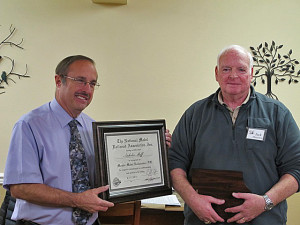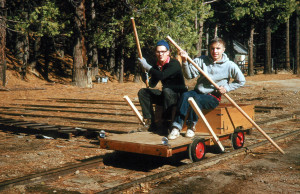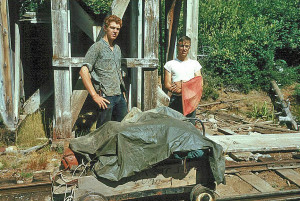by Rich Thom, photos by Al Frasch and from Nick Muff Collection
Chairperson Rich Blake welcomed 33 attendees to the Skagit Valley and Whidbey Clinic’s third meeting of the season on Wednesday, November 12th. Rich was pleased to point out that several folks from the mainland, who are now regulars of the new Mt. Vernon Clinic, were in the audience tonight. Our two clinics are scheduled about two weeks apart each month, giving area modelers the opportunity to attend both if they wish. That idea seems to be a good one!
Also making the trip to the island were Jack Hamilton and Di Voss, devoting their entire day prior to the clinic to evaluating layouts, rolling stock, scenery, buildings, and even volunteer data, resulting in several NMRA AP awards being earned by SV & W modelers. Thanks, gentlemen, for taking the time and driving the distance year after year; it has really vitalized the AP program in our area. Jack described the AP program and how rewarding — and relatively easy — it is to accumulate points for your modeling, authoring, volunteering, and operations efforts. He noted that working towards the “car” award seemed to be a particularly common roadblock for some of our SV&W modelers, who otherwise were within shouting distance of earning their MMR (Master Model Railroader). As just one result of the day’s judging, Jack called Tom Hawkins to the front and presented him with his Golden Spike Award. Tom was one of the winners of a layout design competition run by Model Railroader magazine, and his layout was featured in the magazine.
Next, as Rich Blake pointed out, it really was Dr. Nick Muff Night. Jack presented Nick with his MMR certificate and plaque, remarking that whenever he visited Nick’s layout, he returned home and contemplated taking a sledgehammer to his own. (Your reporter has had the same emotion!). If ever you are able to visit Nick’s world-class layout, simply look at the chandeliers in the Kansas City station and you will understand that sledgehammer urge.
Nick was also the presenter of the evening’s program, an historic collection of his still photographs and 8mm film of the West Side Lumber Company. Just as remarkable as the photos were the “vehicles” that Nick and two friends used to travel over the railroad, the entertaining stories about how they were built, and the adventures they shared on the rides. The vehicles? Homemade handcars — a series of three of them no less — each one significantly better than the last.
Nick visited the West Side many times between 1961-66; his earliest explorations in 1961-62, when he was 16, were the subject of tonight’s talk. The West Side’s 3-ft gauge railroad operations had been in gradual decline and finally were abandoned altogether in midyear 1961; only a single steamer, standard-gauge Heisler #3, continued working the mill in Tuolumne. After that, gyppo truck loggers brought timber down to the mill. However Pickering, who owned the West Side, stored the locos rather than scrapping them, and kept the track in place, too, just in case relying on the gyppos didn’t work out. The entire line was ripe for exploring by three keen teenagers.
Nick opened with slides shot in Tuolumne: the large mill operation; Heisler #3; some of the charming home-built cabeese; the gauntlet track at the log dump; and several of the Shays. The Shays were kept in immaculate condition, mechanically and in appearance, too; paint gleamed on most of them in Nick’s photos.
The boys hiked much of the line on their first forays, and soon realized that this was one long railroad! Camp 45 — the last camp built for railroad logging — was 56 miles from Tuolumne, and the main line at one time was 70 miles long. To speed things up, they built their first handcar — their “Car # 1.” It had no pump mechanism and was simply a platform, rope-pulled or sometimes “poled.” Its wheels had rubber tires, and those wheels were the biggest problem. The tread just wasn’t wide enough and the car constantly derailed. Nick said that the variations in gauge of the West Side’s rail, as light as 35-pound in places, were so large that any successful car needed 5-inch wide treads!
In 1962, Nick and his friends were at Clavey River bridge when they spotted a wheelset (it appeared to be from some sort of handcar) discarded near the track, and then another nearby. The axles weren’t quite true and wheel flanges had pieces missing but (as Nick put it) there was just enough of the flanges left to keep the wheels on the track. They found a steel frame that fit, and using some 2 x 12’s among the scrap they built a floor and other wood parts for their new Car #2, built entirely in the woods! With wider treads and sturdier all around, it was a clear improvement over #1. Intending to return to Tuolumne on their new creation, things went awry. A severe rainstorm came up quickly, necessitating a night spent on soaked bedrolls and, eventually, their rescue by the county Sheriff, who was not pleased.
Undeterred, Car #2 was improved yet again with the addition of a 5 hp engine, and proudly lettered West Side #3. On it Nick and the others could now make the trip out to Camp 45 in style. But not without more adventure. Returning to Tuolumne, #3 had an unfortunate encounter with some 2 x 12’s which a farmer had used to “enhance” his cattle guards, the boys jumped off, and off went Car #3 too, picking up speed and outpacing its pursuers on the downhill grade into Tuolumne. Would the handcar (possibly on fire) crash into Tuolumne yard and get Nick and friends into some really serious trouble this time?
If you’d heard Nick’s talk, you’d know. If Nick ever gives this talk again at another clinic, a regional convention, or other gathering, make every effort to get there. You’ll enjoy it.




No Comments Yet